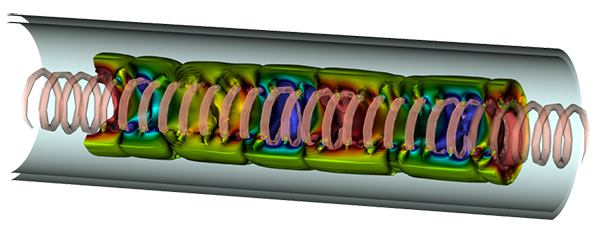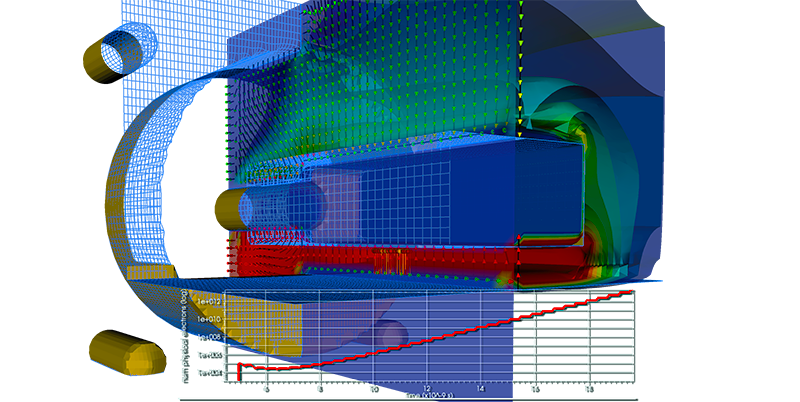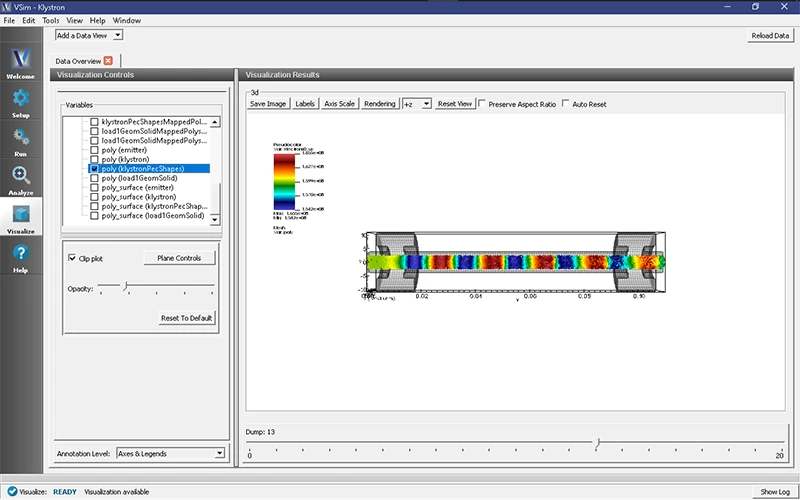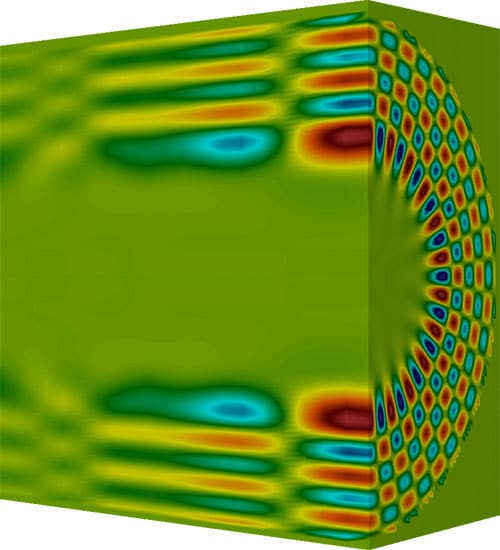

VSimVE Vacuum Electronic and Microwave Device Simulations
VSimVE is an optimized computational application for simulating microwave and vacuum microwave devices. VSimVE can simulate particle physics such as Child-Langmuir space-charged limited emission and Fowler-Nordheim tunneling emission and provides performance diagnostics such as power, voltage, and electron currents. With VSimVE, multipacting at multiple power levels can be computed in a single simulation run, and simulations run rapidly using algorithms designed for high-performance computing systems.
Powerful post-processing and advanced visualization capabilities offer detailed profile and particle distribution data. Featuring the full suite of electromagnetic and particle modeling features and used in the design cycle of components from klystrons to magnetrons, VSimVE is the ideal simulation tool for today’s RF and microwave engineers.

“VSim has been invaluable to us in designing our ladder type TWT. No other code available to us could give the nonlinear beam dynamics of this kind of device. Without the distributed computing capabilities of VSim, these runs would have taken months, making them effectively impossible. Also, the Tech-X support staff was a great help with setting up our problem and getting us to a solution.”
Professor Heather Song
University of Colorado at Colorado Springs
Want To Evaluate VSimVE?
VSimVE Vacuum Electronic Simulation Advantages
- FDTD Code for Complex Simulations
- PIC algorithms for kinetic particle modeling
- Full Suite of EM and particle modeling features
- High Performance Computing Capable
- Documented Accuracy
- Powerful and Versatile Post-Processing
- Seamless Integration with all VSim Modules
- Robust Documentation and Tutorials
- Superior Customer Support


VSimVE Capabilities
- CAD Import
- Easy construction through user interface
- Customizable Materials
- Partially Transparent Absorbers
- Lossfree & Lossy
- Isotropic & Anisotropic
- Second-Order Dispersive
- Surface Emission
- Electron-Induced Surface Emission
- Controlled Emission
- Field-Scaled Particles
- Space-Charge Limited Emission
- Thermionic Emission
- Secondary Emitter Particle Source for Collector Analysis
- Dynamic Particle Weight Settings
- Particle Sinks
- Port Modes
- Discrete Elements & Face Ports
- Plane Waves with Elliptical Polarization
- Full & Scattered Field
- Waveguide Ports
- Current-Based Ampere-Law Sources
- Circuit Equations
- Cerenkov Noise Filter
- Multipacting
- Operating Modes
- Power
- S-Parameters
- Voltage
- Electron Tracking
- Electron Current
- Electron Phase-Space
- Mode Calculations Using Frequency Extraction
- Field and Particle Histories and Feedback
- Phase-Space Analysis
- Particle Tracking
- Embedded Boundaries for Accurate Metallic Walls
- Port Boundaries: Ingoing & Outgoing
- Absorbing & Reflecting Boundaries
- Periodic & Phase-Shift Conditions
- Dey-Mittra Cut-Cell Algorithm for Tight Meshing
- Resistive Wall-Loss Calculations
- PML & MAL Boundaries
- Field Emission
- Fowler-Nordheim Emission
- Laser-Induced Emission
- Prescribed Emission
- Analytic & Importable Static Magnetic Field Capability
- Feedback Control
Ready to evaluate VSimVE?
Applications for VSimVE Microwave Device Simulations
Traveling Wave Tubes
Electron guns
Striplines
Collectors
Couplers
